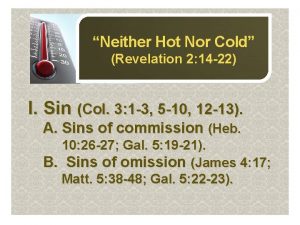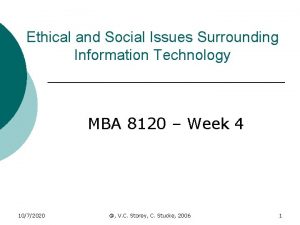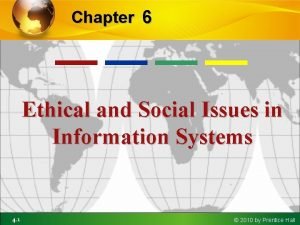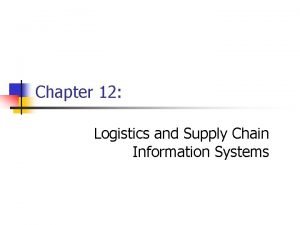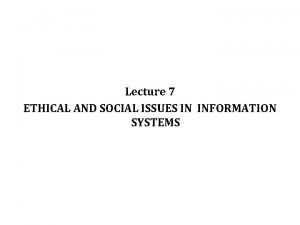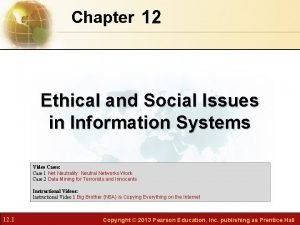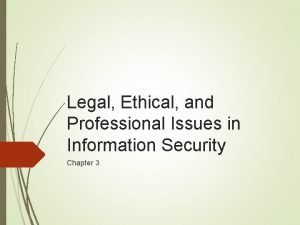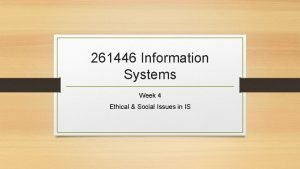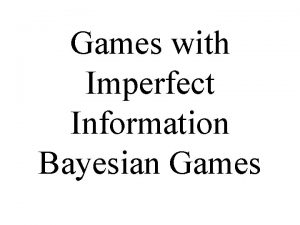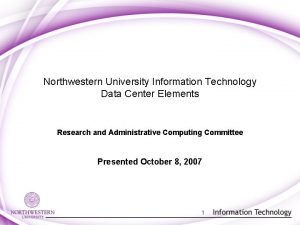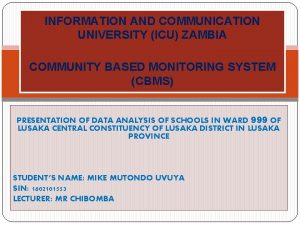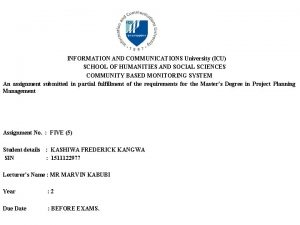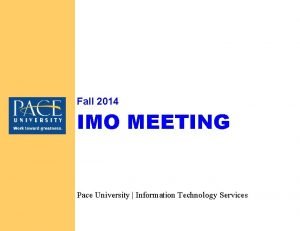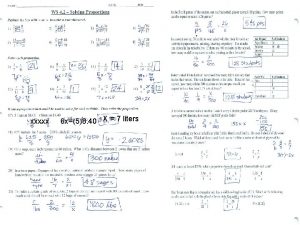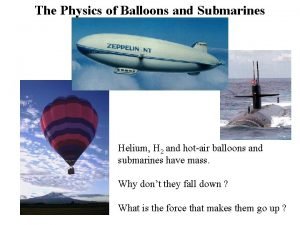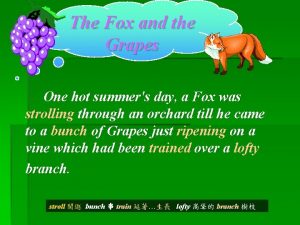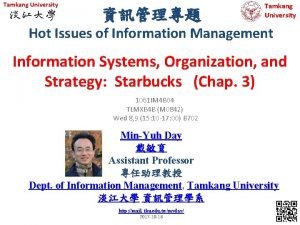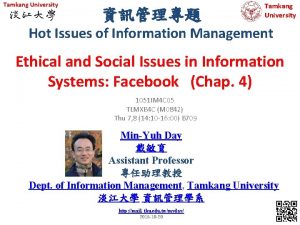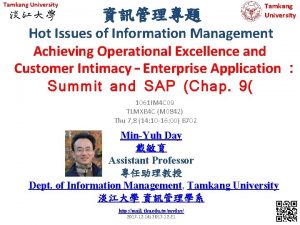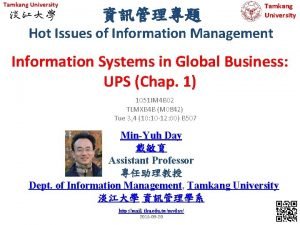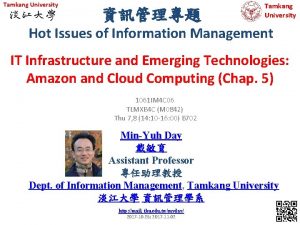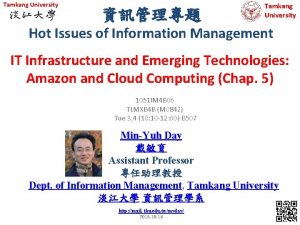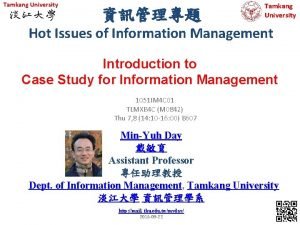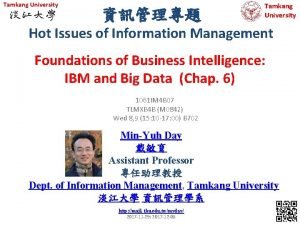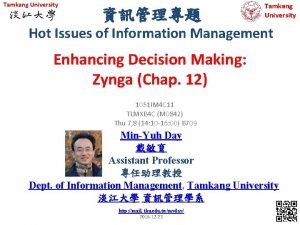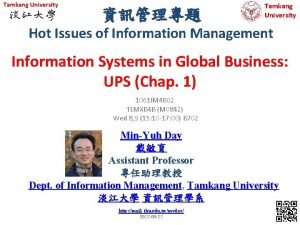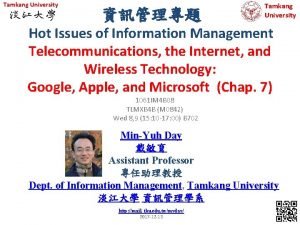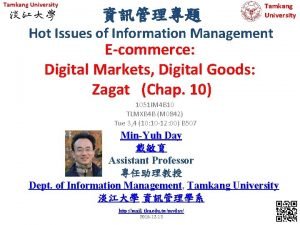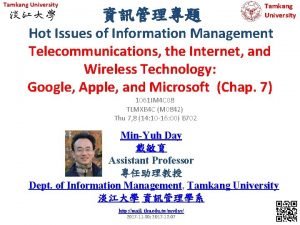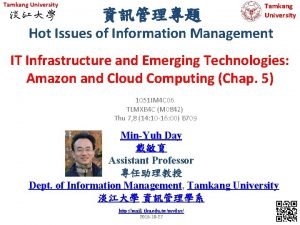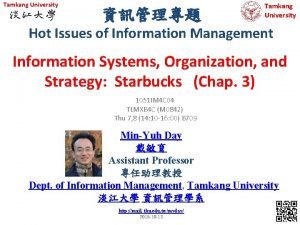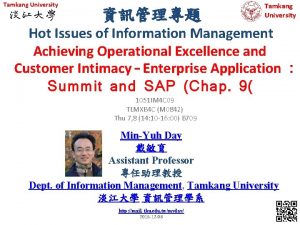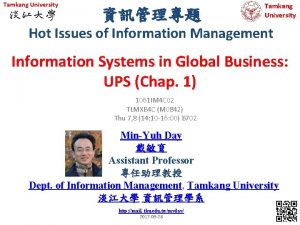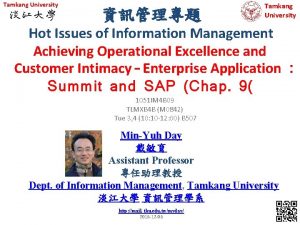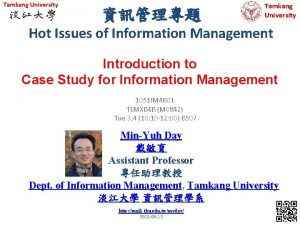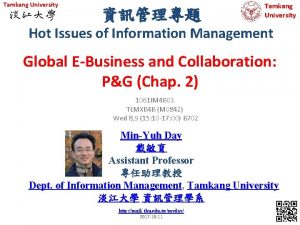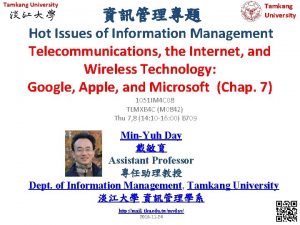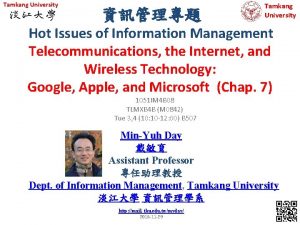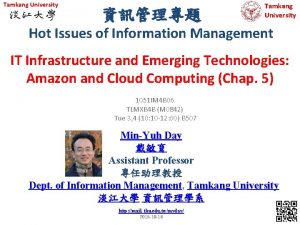Tamkang University Tamkang University Hot Issues of Information




































- Slides: 36

Tamkang University 資訊管理專題 Tamkang University Hot Issues of Information Management Global E-Business and Collaboration: P&G (Chap. 2) 1051 IM 4 B 03 TLMXB 4 B (M 0842) Tue 3, 4 (10: 10 -12: 00) B 507 Min-Yuh Day 戴敏育 Assistant Professor 專任助理教授 Dept. of Information Management, Tamkang University 淡江大學 資訊管理學系 http: //mail. tku. edu. tw/myday/ 2016 -09 -27 1

課程大綱 (Syllabus) 週次 (Week) 日期 (Date) 內容 (Subject/Topics) 1 2016/09/13 Introduction to Case Study for Information Management Hot Topics 2 2016/09/20 Information Systems in Global Business: UPS (Chap. 1) (pp. 53 -54) 3 2016/09/27 Global E-Business and Collaboration: P&G (Chap. 2) (pp. 84 -85) 4 2016/10/04 Information Systems, Organization, and Strategy: Starbucks (Chap. 3) (pp. 129 -130) 5 2016/10/11 Ethical and Social Issues in Information Systems: Facebook (Chap. 4) (pp. 188 -190) 2

課程大綱 (Syllabus) 週次 (Week) 日期 (Date) 內容 (Subject/Topics) 6 2016/10/18 IT Infrastructure and Emerging Technologies: Amazon and Cloud Computing (Chap. 5) (pp. 234236) 7 2016/10/25 Foundations of Business Intelligence: IBM and Big Data (Chap. 6) (pp. 261 -262) 8 2016/11/01 Telecommunications, the Internet, and Wireless Technology: Google, Apple, and Microsoft (Chap. 7) (pp. 318 -320) 9 2016/11/08 Midterm Report (期中報告) 10 2016/11/15 期中考試週 3

課程大綱 (Syllabus) 週次 日期 內容(Subject/Topics) 11 2016/11/22 Enterprise Applications: Summit and SAP (Chap. 9) (pp. 396 -398) 12 2016/11/29 E-commerce: Zagat (Chap. 10) (pp. 443 -445) 13 2016/12/06 Enhancing Decision Making: Zynga (Chap. 12) (pp. 512 -514) 14 2016/12/13 Building Information Systems: USAA (Chap. 13) (pp. 547 -548) 15 2016/12/20 Managing Projects: NYCAPS and City. Time (Chap. 14) (pp. 586 -588) 16 2016/12/27 Final Report I (期末報告 I) 17 2017/01/03 Final Report II (期末報告 II) 18 2017/01/10 期末考試週 4

Management Information Systems: Managing the Digital Firm 1 2 3 4 Organization, Management, and the Networked Enterprise Information Technology Infrastructure Key System Applications for the Digital Age Building and Managing Systems Source: Kenneth C. Laudon & Jane P. Laudon (2014), Management Information Systems: Managing the Digital Firm, Thirteenth Edition, Pearson. 5

Chap. 2 Global E-Business and Collaboration: P&G 6

Case Study: P&G (Chap. 2) (pp. 84 -85) Piloting Procter & Gamble from Decision Cockpits 1. What management, organization, and technology issues had to be addressed when implementing Business Sufficiency, Business Sphere, and Decision Cockpits? 2. How did these decision-making tools change the way the company ran its business? How effective are they? Why? 3. How are these systems related to P&G’s business strategy? Source: Kenneth C. Laudon & Jane P. Laudon (2014), Management Information Systems: Managing the Digital Firm, Thirteenth Edition, Pearson. 7

Overview of Fundamental MIS Concepts Business Challenges Management Organization Information System Business Solutions Technology Source: Kenneth C. Laudon & Jane P. Laudon (2014), Management Information Systems: Managing the Digital Firm, Thirteenth Edition, Pearson. 8

Business Model 8 6 2 4 Key Activities Key Partners 7 Customer Relationships Value Proposition Key Resources 9 Cost Structure 1 Customer Segments 3 Channels 5 Revenue Streams Source: Alexander Osterwalder & Yves Pigneur, Business Model Generation: A Handbook for Visionaries, Game Changers, and Challengers, Wiley, 2010. 9

The Order Fulfillment Process Source: Kenneth C. Laudon & Jane P. Laudon (2014), Management Information Systems: Managing the Digital Firm, Thirteenth Edition, Pearson. 10

A Payroll TPS Source: Kenneth C. Laudon & Jane P. Laudon (2014), Management Information Systems: Managing the Digital Firm, Thirteenth Edition, Pearson. 11

How Management Information Systems Obtain Their Data from the Organization’s TPS Source: Kenneth C. Laudon & Jane P. Laudon (2014), Management Information Systems: Managing the Digital Firm, Thirteenth Edition, Pearson. 12

Voyage-Estimating Decision Support System Source: Kenneth C. Laudon & Jane P. Laudon (2014), Management Information Systems: Managing the Digital Firm, Thirteenth Edition, Pearson. 13

Enterprise Application Architecture Source: Kenneth C. Laudon & Jane P. Laudon (2014), Management Information Systems: Managing the Digital Firm, Thirteenth Edition, Pearson. 14

Requirements for Collaboration Source: Kenneth C. Laudon & Jane P. Laudon (2014), Management Information Systems: Managing the Digital Firm, Thirteenth Edition, Pearson. 15

The Time/Space Collaboration Tool Matrix Source: Kenneth C. Laudon & Jane P. Laudon (2014), Management Information Systems: Managing the Digital Firm, Thirteenth Edition, Pearson. 16

The Information Systems Function in Business • Information systems department: – Formal organizational unit responsible for information technology services – Often headed by chief information officer (CIO) • Other senior positions include chief security officer (CSO), chief knowledge officer (CKO), chief privacy officer (CPO) – Programmers – Systems analysts – Information systems managers Source: Kenneth C. Laudon & Jane P. Laudon (2014), Management Information Systems: Managing the Digital Firm, Thirteenth Edition, Pearson. 17

The Information Systems Function in Business • End users – Representatives of other departments for whom applications are developed – Increasing role in system design, development • IT Governance: – Strategies and policies for using IT in the organization – Decision rights – Accountability – Organization of information systems function • Centralized, decentralized, and so on Source: Kenneth C. Laudon & Jane P. Laudon (2014), Management Information Systems: Managing the Digital Firm, Thirteenth Edition, Pearson. 18

Definition of Business Model A business model describes the rationale of how an organization creates, delivers, and captures value. Source: Alexander Osterwalder & Yves Pigneur, Business Model Generation: A Handbook for Visionaries, Game Changers, and Challengers, Wiley, 2010. 19

Definition of Business Strategy A business strategy is a long term plan of action designed to achieve a particular goal or set of goals or objectives. Source: (Ostenwalder, Pigneur and Tucci, 2005) 20

Business • “the activity of providing goods and services involving financial, commercial and industrial aspects. ” (Word. Net 2. 0) Source: (Ostenwalder, Pigneur and Tucci, 2005) 21

Model • “a simplified description and representation of a complex entity or process. ” (Word. Net 2. 0) Source: (Ostenwalder, Pigneur and Tucci, 2005) 22

Business Model • A business model is a conceptual tool containing a set of objects, concepts and their relationships with the objective to express the business logic of a specific firm. • Therefore we must consider which concepts and relationships allow a simplified description and representation of what value is provided to customers, how this is done and with which financial consequences. Source: (Ostenwalder, Pigneur and Tucci, 2005) 23

Business Model Concept Hierarchy Source: (Ostenwalder, Pigneur and Tucci, 2005) 24

Business Model vs. Business Process Model • Business Model – a view of the firm's logic for creating and commercializing value • Business process model – how a business case is implemented in processes Source: (Ostenwalder, Pigneur and Tucci, 2005) 25

Business Model vs. Strategy • Business Models – a system that shows how the pieces of a business fit together. – an abstraction of a firm's strategy • Strategy – includes competition Source: (Ostenwalder, Pigneur and Tucci, 2005) 26

Implementing Business Models Source: (Ostenwalder, Pigneur and Tucci, 2005) 27

The Business Model's Place in the Firm Source: (Ostenwalder, Pigneur and Tucci, 2005) 28

Nine Business Model Building Blocks Source: (Ostenwalder, Pigneur and Tucci, 2005) 29

Planning, Changing and Implementing Business Models Source: (Ostenwalder, Pigneur and Tucci, 2005) 30

Business Strategy and Information Systems Alignment Source: (Ostenwalder, Pigneur and Tucci, 2005) 31

Business and IT/IS Alignment Source: (Ostenwalder, Pigneur and Tucci, 2005) 32

Infrastructure Alignment Source: (Ostenwalder, Pigneur and Tucci, 2005) 33

Case Study: Starbucks (Chap. 3) (pp. 129 -130) Technology Helps Starbucks Find New Ways to Compete 1. Analyze Starbucks using the competitive forces and value chain models. 2. What is Starbucks’ business strategy? Assess the role played by technology in this business strategy. 3. How much has technology helped Starbucks compete? Explain your answer. Source: Kenneth C. Laudon & Jane P. Laudon (2014), Management Information Systems: Managing the Digital Firm, Thirteenth Edition, Pearson. 34


References – Kenneth C. Laudon & Jane P. Laudon (2014), Management Information Systems: Managing the Digital Firm, Thirteenth Edition, Pearson. – Kenneth C. Laudon & Jane P. Laudon原著, 游張松 主編,陳文生 翻譯 (2014), 資訊管理系統,第 13版,滄海 36
 White hot vs red hot temperature
White hot vs red hot temperature Cold working advantages
Cold working advantages Perbedaan hot lava dan hot lava volcano
Perbedaan hot lava dan hot lava volcano Be either hot or cold
Be either hot or cold Legal ethical and societal issues in media and information
Legal ethical and societal issues in media and information Issues surrounding information privacy
Issues surrounding information privacy Ethical and social issues in information systems doc
Ethical and social issues in information systems doc Ethical and social issues in information systems doc
Ethical and social issues in information systems doc Legal and ethical issues in media
Legal and ethical issues in media Chapter 4 ethical issues
Chapter 4 ethical issues Contemporary issues in information systems
Contemporary issues in information systems Information about social issues
Information about social issues Social issues in technology management
Social issues in technology management Legal and ethical issues in information security
Legal and ethical issues in information security 4 components of an information system
4 components of an information system Ethical and social issues in information systems
Ethical and social issues in information systems Imperfect vs incomplete information
Imperfect vs incomplete information Northwestern university information technology
Northwestern university information technology Icu zambia assignments
Icu zambia assignments Tashkent university of information technology
Tashkent university of information technology Department of information engineering university of padova
Department of information engineering university of padova Department of information engineering university of padova
Department of information engineering university of padova List of lecturers at icu zambia
List of lecturers at icu zambia Pace university information technology
Pace university information technology 沈榮麟
沈榮麟 Hot pack endikasyonları
Hot pack endikasyonları Xxxxx6
Xxxxx6 Diagram of hot air oven
Diagram of hot air oven Why is las vegas so hot
Why is las vegas so hot Types of cold sandwiches
Types of cold sandwiches Osha hot work standard
Osha hot work standard Soaker visbreaking
Soaker visbreaking Laslo erdes
Laslo erdes What keeps the sun hot
What keeps the sun hot Physics of hot air balloons
Physics of hot air balloons What is the theme of the fox and the grapes
What is the theme of the fox and the grapes Message hot oil
Message hot oil



